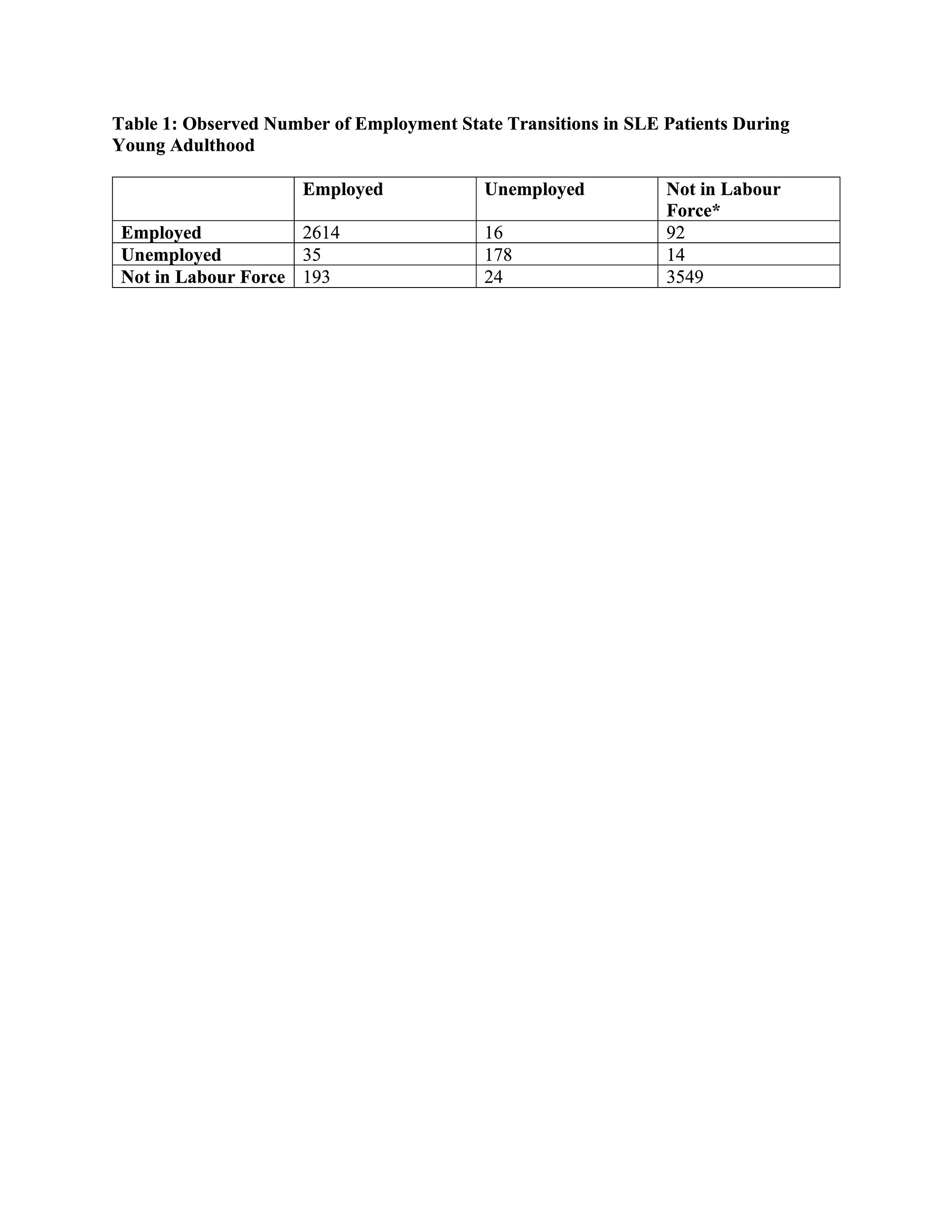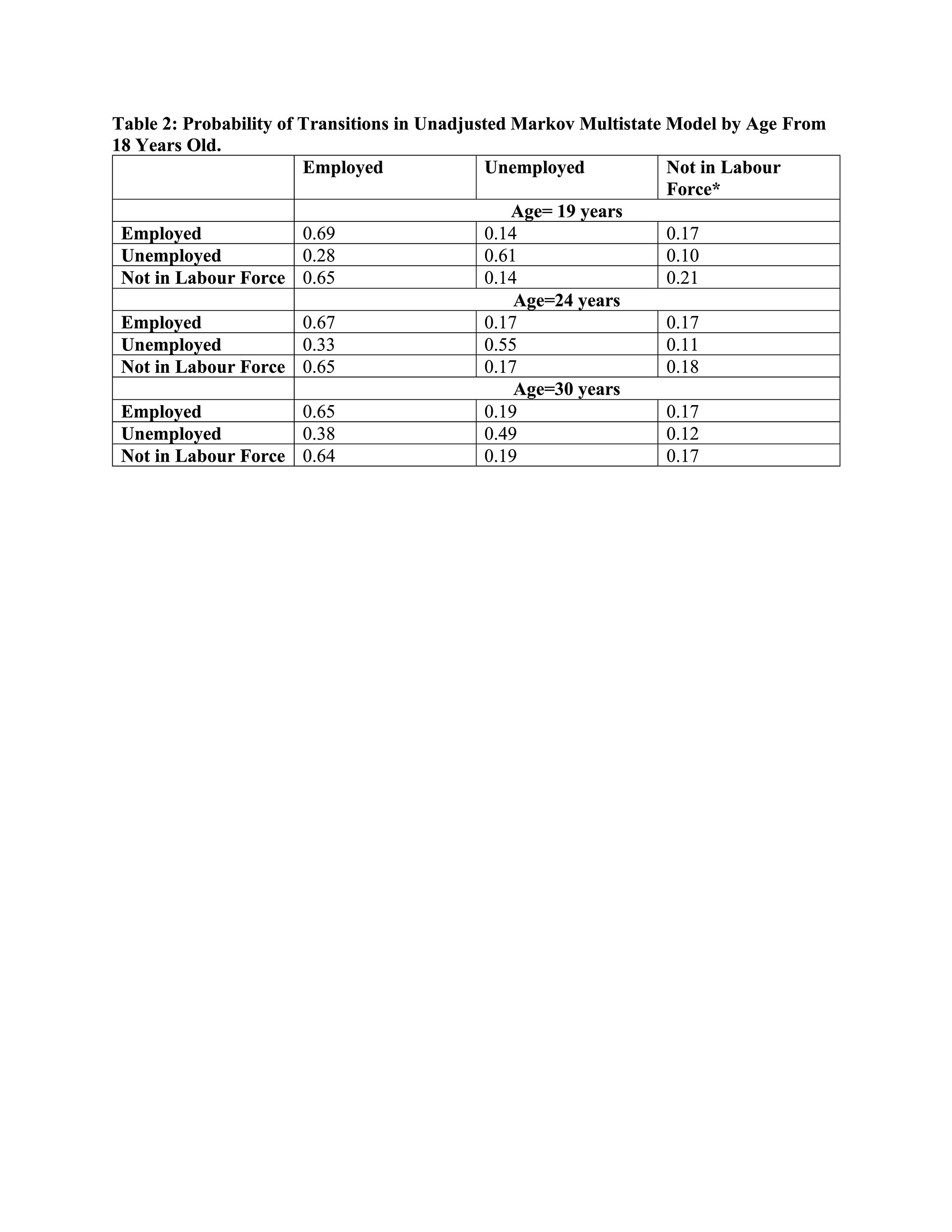Session Information
Date: Monday, November 14, 2022
Title: SLE – Diagnosis, Manifestations, and Outcomes Poster III: Outcomes
Session Type: Poster Session D
Session Time: 1:00PM-3:00PM
Background/Purpose: Young adulthood (18-30 years) is a time of many changes. Young adults finish school, enter the labour force, and maybe start their own families. Failing to establish employment during young adulthood could predict lifetime financial hardships. Lack or limited employment could limit access to healthcare benefits and treatments, adversely affecting health outcomes. We aim to determine the average employment trajectory of childhood- and adult-onset systemic lupus erythematosus patients in young adulthood (YASLE).
Methods: In this retrospective longitudinal cohort study of patients from two cohorts: the Canadian Network for Improved Outcomes in SLE, CaNIOS) cohort and the University of Toronto (UT) lupus cohort from Toronto Western Hospital. CaNIOS cohort included participants from multiple provinces (2002-2020). The UT cohort included only patients from Ontario, Canada (1983-2020). Employment trajectories between 18 to 30 years were studied. Only patients with ≥ 2 visits were included. Employment state was collected annually. The employment states collected were: employed, unemployed, homemaker, student, work disabled. The Markov multistate model (msm) was used to model employment trajectory. Reduced number of employment states: employed, unemployed or not in labour force (NLF, i.e. student, homemaker, work disabled), were used for Markov msm. Transition probabilities at 1, 6, 12 years from age 18 years were calculated.
Results: 841 patients (718 females, 85%) were studied: 253 and 588 from the CaNIOS and UT cohorts respectively. The mean age (standard deviation, SD) at baseline for the combined cohort was 23.1 (SD 3.7) years. The age distribution of patients was: 38% (18-20 years), 19% (21-23 years), 22% (24-26 years), 21% (27-30 years). 403 (48%) were cSLE. 90% completed high school at study entry. Median years of disease at cohort entry was 3.3 (0.7-6.6, 25th-75th percentile, P). Median years of follow-up was 2.8 (0.9- 6.5, 25th-75th P). At cohort entry, 140 (17%) were employed, 47 (6%) were unemployed and 654 (78%) were NLF (42 work disabled, 226 homemakers, 386 students). Of 6615 visits, 374 (6%) showed state changes; 58% of changing states occurred in the NLF group (Table 1). Students accounted for 64% of state changes in the NLF group. YASLE patients have the highest probabilities of remaining in the same employment state as baseline (Table 2). There was a lowering rate of staying employed with increasing age (0.69 to 0.64). The baseline unemployed showed minimal increase in becoming employed (from 0.28 to 0.38). The baseline NLF group has stable rate of transition to employment (0.65), without expected increase with increasing age.
Conclusion: YASLE patients showed minimal or no increase in transitions into employment from non-employed states, and no increase in employment with age as expected in the general young adult population. This could suggest a lowered labour force attachment in YASLE patients, suggesting difficulties in establishing employment during young adulthood. Future work should focus on YASLE patients’ perceived barriers and facilitators for employment, to target interventions for supporting patients’ employment.
To cite this abstract in AMA style:
Lim L, Konstanidis M, Touma Z, Lacaille D, Oguzoglu U, Peschken C, Anderson N, Kaur R, Pullenayegum E. Employment Trajectory of Canadian Young Adults with Systemic Lupus Erythematosus [abstract]. Arthritis Rheumatol. 2022; 74 (suppl 9). https://acrabstracts.org/abstract/employment-trajectory-of-canadian-young-adults-with-systemic-lupus-erythematosus/. Accessed .« Back to ACR Convergence 2022
ACR Meeting Abstracts - https://acrabstracts.org/abstract/employment-trajectory-of-canadian-young-adults-with-systemic-lupus-erythematosus/


